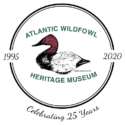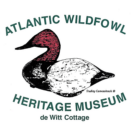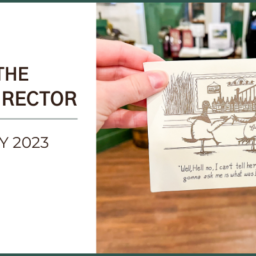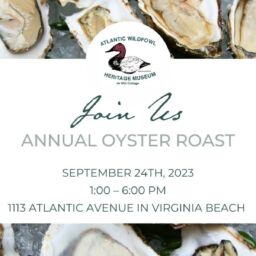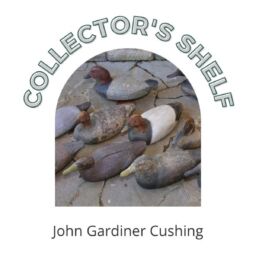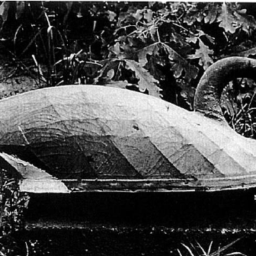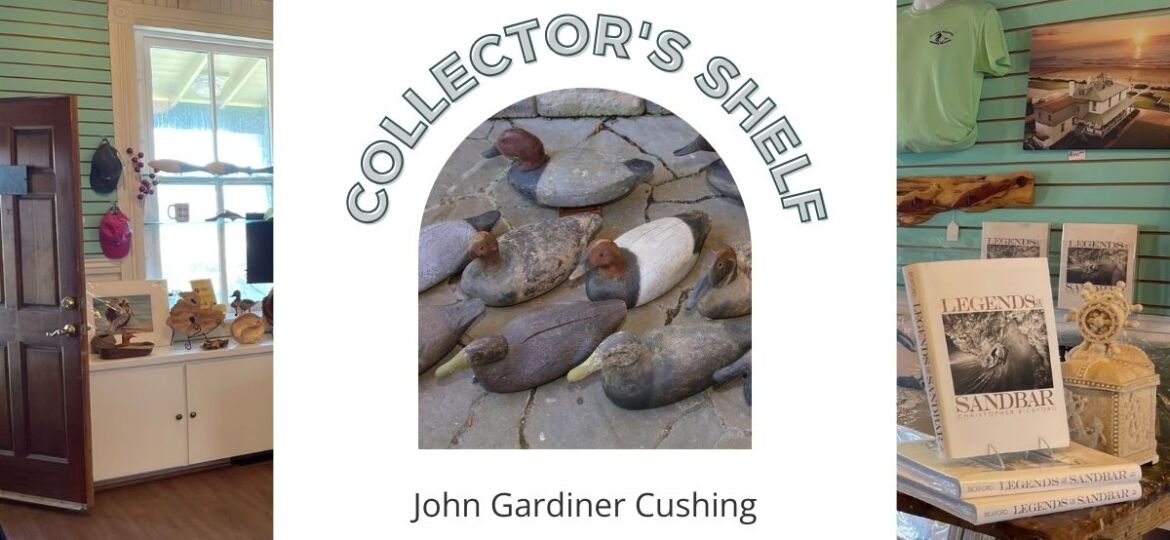
Next, we have more of our factory decoys. These bear the brand/stamp “J G CUSHING,” with one also branded “CODMAN” (see our previous discussion) and another also branded “LAWRENCE.” (Francis William Lawrence will be presented in a subsequent chronicle.) Once again, the Lighthouse Club Score Book tells us with specificity that “J G CUSHING” is the brand of John Gardiner Cushing, another Boston Brahmin Harvard grad (in 1855), where he was, like many of his fellow Lighthouse Club sportsmen, a member of the Porcellian Club. Mr. Cushing is a somewhat enigmatic figure—we know a bit about him, but considerably more about his immediate family and their descendants. Like other of the club members we are presenting, he is related through marriage to Arthur Amory (making him also related to the others related to Arthur).

His wife, Susan Prescott (Dexter) Cushing (1836-1918) was the daughter of Elizabeth Ann (Amory) Dexter (m. George Minot Dexter), who was the sister of Charles Amory (1808-1898), a distant cousin of our Arthur Amory. (Charles Amory’s grandfather, Thomas Fisher Amory (1722-1784), was Arthur Amory’s great-grandfather.) However, a closer relationship to Arthur exists through Charles Amory’s wife, Martha Babcock (Greene) Amory (Arthur’s aunt—sister of his mother), yet another daughter of the previously mentioned fabulously wealthy Gardiner Greene, Arthur’s grandfather on his mother’s side. Finally, the sister of our John’s wife was Mary Louisa (Dexter) Amory. She married Charles Amory (1836-1871), the son of the aforementioned Charles. Once again, we see Boston Brahmins marrying other Boston Brahmins. The vast wealth of these families was rarely diluted by marriage, just shifted around within the group, giving true meaning to the phrase, “What goes around, comes around!”
John Gardiner Cushing was a direct lineal descendant of Deacon Matthew Cushing, born in England in 1588 in the year of the Spanish Armada. Matthew lived the first fifty years of his life in Hingham, Norfolk County, England. In 1638, he left England for Massachusetts with his wife and five children on the ship “Diligent.” The cause of their migration was purportedly trouble in church matters, a common theme in England during the reign of Charles I prior to the English Revolution. Their party landed at Boston and proceeded to what then became Hingham, MA.
Skipping forward, our John Gardiner Cushing was the oldest son of John Perkins Cushing (1787-1862). John Perkins Cushing was born into a prominent and wealthy Brahmin family, but was orphaned at an early age. As a result, he was raised by his uncle, Thomas Handasyd Perkins (1764-1854), reportedly a hugely wealthy slave trader and smuggler of Turkish opium into China.
As a teenager, John Perkins Cushing went to China to work for his uncle, where he converted the family business into a legitimate and burgeoning enterprise. However, it is reported that he, too, eventually turned to the profitable opium trade, becoming the most influential foreigner in Canton. After 27 years in China, John Perkins Cushing returned to Boston with his Chinese housekeepers, Chinese manners, and great wealth. He immediately became the most eligible bachelor in Boston, choosing to marry our John Gardiner Cushing’s mother, Mary Louisa (Gardiner) Perkins.
In 1861, John Gardiner Cushing and his younger brother, Robert Maynard Cushing (1836-1907), acquired property from the prominent real estate investor Henry Whitwell (whom we will read about later) at 168 and 170 Beacon Street in Boston. Several Lighthouse Club members resided on Beacon St. Recall that our Gardiner Greene Hammond lived at 172 Beacon St. Also, John Lowell Gardner II (1837-1898), another Lighthouse Club sportsman, lived at 182 Beacon St. next to the previously mentioned Somerset Club, of which many of our Lighthouse Club’s sportsmen were members. [In a side note, John Lowell Gardner’s sister, Julia (Gardner) Coolidge, married Joseph Randolph Coolidge, whose mother was the granddaughter of Founding Father and U.S. President Thomas Jefferson. Gardner’s daughter-in-law, Harriet Sears (Amory) Gardner (1835-1865; m. Joseph Peabody Gardner) was the daughter of William Amory (1804-1888), great uncle of Arthur Amory, and the aunt of Charles Pelham Curtis III’s wife, Ellen (Amory) Curtis.] Real estate investor Henry Whitwell, himself, lived at 79 Beacon St. with his parents, who moved to 161 Beacon St. in the mid-1860s. Beacon St. was obviously an upscale neighborhood where many Boston Brahmins resided.
In 1867, John’s aforementioned younger brother Robert acquired property on one of Newport, Rhode Island’s most spectacular promontories overlooking the water. There, he built “The Ledges,” a stately home overlooking Bailey’s Beach which remains today in the Cushing family. Along with George Richmond Fearing (one of the six Lighthouse Club founding members), Robert co-founded the Newport “Casino,” a social club that later became today’s International Tennis Hall of Fame. While originally built as a summer home, Robert eventually retired at “The Ledges”. His son, Howard Gardiner Cushing (1869-1916), made “The Ledges” his home, where his inherited wealth afforded him the opportunity to indulge his passion for painting. He became a prominent artist. Perhaps most interesting of all, however, was Howard’s son, Alexander Cochrane Cushing (1913-2006). Alexander graduated from Harvard Law in 1939 and went to work at the U.S. State and then Justice Departments. Following the attack on Pearl Harbor, he entered the Navy’s first officer training class at Quonset Point.
At the end of the war, he left the service as a Lt. Commander and returned to the practice of law with a NYC firm. But here’s the most interesting part: during a 1950s ski vacation to Sierra, Nevada, he visited Squaw Valley at Lake Tahoe. He immediately saw its great possibility as a ski resort. After assembling a group of investors to acquire and develop the property as a ski resort, he began promoting it to the International Olympic Committee as a site for the eighth Winter Olympics. He was eventually successful in his efforts, and Squaw Valley hosted the 1960 Winter Olympics, besting the St. Moritz, Switzerland and Innsbruck, Austria venues. Due to this success, he appeared on the cover of Time magazine in 1959. In 1999, he was inducted into the Ski Industry Hall of Fame for his contributions to the sport. He died in 2006 at his summer home in Newport, RI—“The Ledges.” So here we have John Gardiner Cushing and his extended family, yet another view into the Boston Brahmins from the Gilded Age. Again, we are left to wonder what conversations he shared in the blind over the decoys pictured here.
